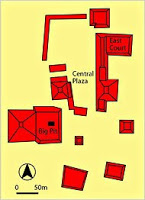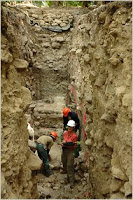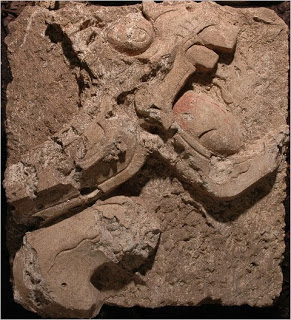Arqueologia
 foto Takeshi Inomata .The palace of the Terminal Classic kings. The throne is in the center room.
foto Takeshi Inomata .The palace of the Terminal Classic kings. The throne is in the center room.
By DANIELA TRIADAN
I have been stuck in the trench at the East Court for three seasons and have been supervising operations there since 2006. We decided to excavate there because we thought that the buildings around this elevated plaza might have been used as the royal palace of Ceibal during the last years of its occupation, in the period called the Terminal Classic (about A.D. 830 to 980). We also wanted to explore the earlier occupation phases of this seven-meter-high platform and see how they may be related to its final use by the kings of Ceibal. Two early test excavations by the Harvard project had shown substantial Preclassic construction layers.
 It turned out that the East Court was indeed the royal palace during the last years of Ceibal. We found a magnificent building with a throne room and a painted stucco facade flanking two other buildings in the courtyard. The investigations by Harvard indicated that during the preceding period (A.D. 600 to 830) the kings of Ceibal probably lived at a more defensible location, while our evidence of the earliest occupation of the site points to its use as the city’s ceremonial center. By the beginning of the end of Ceibal, the last rulers built a new palace complex in the East Court, and one of our questions is, why here?
It turned out that the East Court was indeed the royal palace during the last years of Ceibal. We found a magnificent building with a throne room and a painted stucco facade flanking two other buildings in the courtyard. The investigations by Harvard indicated that during the preceding period (A.D. 600 to 830) the kings of Ceibal probably lived at a more defensible location, while our evidence of the earliest occupation of the site points to its use as the city’s ceremonial center. By the beginning of the end of Ceibal, the last rulers built a new palace complex in the East Court, and one of our questions is, why here?
 foto Takeshi Inomata .The deep trench in the East Court in 2010.
foto Takeshi Inomata .The deep trench in the East Court in 2010.
After exposing the latest buildings, we started several deep trench excavations in front of the Terminal Classic buildings to get information about the earlier constructions in this area. Last year one of these excavations reached 7.4 meters in front of the stuccoed building, revealing 27 floors and an occupation as early as that found in the “Big Pit” and the Central Plaza. We still had not reached bedrock by the end of the season. Deep excavations in front of the other buildings of the court revealed massive Middle Preclassic (600 to 300 B.C.) constructions with large buildings that formed a courtyard very similar to the very latest configuration in the Terminal Classic 1,300 years later. These excavations showed us that this area had been a very important place since the beginning of the site and that all of the seven-meter-high platform that we see today was built by the Maya.
The Terminal Classic was a politically unstable period, and most of the big Maya cities in the region had already been abandoned. Ceibal itself had come under the power of another kingdom in the eighth century and only around A.D. 800 emerged from this political domination. We think that the Terminal Classic kings built their new palace here precisely because it had been an important place since time immemorial. By building their palace in this spot, they deliberately emphasized their connection to their very remote ancestors, the founders of Ceibal, which helped them to legitimize their rule and to reconsolidate their power.
 foto Takeshi Inomata Part of the stucco frieze of the palace.
foto Takeshi Inomata Part of the stucco frieze of the palace.
But we still needed to find out where settlement first took place. When we arrived this year, ready to continue the deep pit in front of the palace building, we found that part of it had become unstable. Obviously we could not continue working in this excavation. A part of another deep trench also became somewhat unstable, and we decided to secure one area of this excavation with lime mortar to be able to dig deeper. Because of these difficulties, we expanded the old Harvard excavation into a 4-by-5-meter area, so that we would have more space to take it to the origins of occupation.
I would like to thank the readers of this blog who were concerned for my safety. I can assure you that I am not suicidal and that my husband does not want to get rid of me — or at least I think he doesn’t. I am even more zealous about pit safety than about excavation forms or the stomachs of the crew, especially as my workers and I have to go down there all the time. The fills are very solid clays that are not moving, and where we detect potential problems we either shore areas up with planks or consolidate them with lime mortar. For instance, in the deep pit that caused so much concern, we spent a week consolidating the section of problematic fill. But thank you again for looking out for me.
 Daniela Triadan, an associate professor of anthropology at the University of Arizona, writes from Guatemala, where she and Takeshi Inomata are excavating the Maya site of Ceibal.
Daniela Triadan, an associate professor of anthropology at the University of Arizona, writes from Guatemala, where she and Takeshi Inomata are excavating the Maya site of Ceibal.
Fonte: http://scientistatwork.blogs.nytimes.com/2011/02/24/maya-kings-and-their-ancestors/ (22/02/2011)
- Archaeologist Investigates Legend Of Mythical Ruler Of Ancient Peru
Posted by TANNAmericas,ArchaeoHeritage,Archaeology,Breakingnews,Peru,South America. Long before the Spanish arrived in Peru in 1530 and brought with them a written language with which to record history, legends about ancient Peru were passed down through...
- Aké (yucatan, Mexico)
The Battle of Aké and the Conquest of Yucatan. By Nicoletta Maestri Aké is an important Maya site in northern Yucatan, around 20 miles from Mérida. The site lies within the terrains of an early 20th century henequen plant, a fiber used to produce...
- More On Mayan Archaeological Sites, Graves Found In Southeastern Mexico
Foto: Cuzam archaeological site [Credit: Archaeologist Luis Pantoja/INAH] Specialists from the National Institute of Anthropology and History (INAH) identified seven new Prehispanic Maya sites and a high concentration of human burials in the town of Sitpach,...
- Mayan Archaeological Sites, Graves Found In Southeastern Mexico
Mexican experts have discovered seven new Mayan archaeological sites and an "important concentration" of pre-Columbian graves in the southeastern state of Yucatan, the National Institute of Anthropology and History, or INAH, said. The vestiges, which...
- Maya Collapse And Modern Society
A spoon-shaped greenstone ornament (about two inches long) found in the excavation tunnel at Ceibal. The object was probably worn by an early community leader as a pectoral and then placed in a cache in a communal ritual. Por Takeshi. By TAKESHI INOMATA...
Arqueologia
Maya Kings and Their Ancestors
 foto Takeshi Inomata .The palace of the Terminal Classic kings. The throne is in the center room.
foto Takeshi Inomata .The palace of the Terminal Classic kings. The throne is in the center room.By DANIELA TRIADAN
I have been stuck in the trench at the East Court for three seasons and have been supervising operations there since 2006. We decided to excavate there because we thought that the buildings around this elevated plaza might have been used as the royal palace of Ceibal during the last years of its occupation, in the period called the Terminal Classic (about A.D. 830 to 980). We also wanted to explore the earlier occupation phases of this seven-meter-high platform and see how they may be related to its final use by the kings of Ceibal. Two early test excavations by the Harvard project had shown substantial Preclassic construction layers.
 It turned out that the East Court was indeed the royal palace during the last years of Ceibal. We found a magnificent building with a throne room and a painted stucco facade flanking two other buildings in the courtyard. The investigations by Harvard indicated that during the preceding period (A.D. 600 to 830) the kings of Ceibal probably lived at a more defensible location, while our evidence of the earliest occupation of the site points to its use as the city’s ceremonial center. By the beginning of the end of Ceibal, the last rulers built a new palace complex in the East Court, and one of our questions is, why here?
It turned out that the East Court was indeed the royal palace during the last years of Ceibal. We found a magnificent building with a throne room and a painted stucco facade flanking two other buildings in the courtyard. The investigations by Harvard indicated that during the preceding period (A.D. 600 to 830) the kings of Ceibal probably lived at a more defensible location, while our evidence of the earliest occupation of the site points to its use as the city’s ceremonial center. By the beginning of the end of Ceibal, the last rulers built a new palace complex in the East Court, and one of our questions is, why here? foto Takeshi Inomata .The deep trench in the East Court in 2010.
foto Takeshi Inomata .The deep trench in the East Court in 2010.After exposing the latest buildings, we started several deep trench excavations in front of the Terminal Classic buildings to get information about the earlier constructions in this area. Last year one of these excavations reached 7.4 meters in front of the stuccoed building, revealing 27 floors and an occupation as early as that found in the “Big Pit” and the Central Plaza. We still had not reached bedrock by the end of the season. Deep excavations in front of the other buildings of the court revealed massive Middle Preclassic (600 to 300 B.C.) constructions with large buildings that formed a courtyard very similar to the very latest configuration in the Terminal Classic 1,300 years later. These excavations showed us that this area had been a very important place since the beginning of the site and that all of the seven-meter-high platform that we see today was built by the Maya.
The Terminal Classic was a politically unstable period, and most of the big Maya cities in the region had already been abandoned. Ceibal itself had come under the power of another kingdom in the eighth century and only around A.D. 800 emerged from this political domination. We think that the Terminal Classic kings built their new palace here precisely because it had been an important place since time immemorial. By building their palace in this spot, they deliberately emphasized their connection to their very remote ancestors, the founders of Ceibal, which helped them to legitimize their rule and to reconsolidate their power.
 foto Takeshi Inomata Part of the stucco frieze of the palace.
foto Takeshi Inomata Part of the stucco frieze of the palace.But we still needed to find out where settlement first took place. When we arrived this year, ready to continue the deep pit in front of the palace building, we found that part of it had become unstable. Obviously we could not continue working in this excavation. A part of another deep trench also became somewhat unstable, and we decided to secure one area of this excavation with lime mortar to be able to dig deeper. Because of these difficulties, we expanded the old Harvard excavation into a 4-by-5-meter area, so that we would have more space to take it to the origins of occupation.
I would like to thank the readers of this blog who were concerned for my safety. I can assure you that I am not suicidal and that my husband does not want to get rid of me — or at least I think he doesn’t. I am even more zealous about pit safety than about excavation forms or the stomachs of the crew, especially as my workers and I have to go down there all the time. The fills are very solid clays that are not moving, and where we detect potential problems we either shore areas up with planks or consolidate them with lime mortar. For instance, in the deep pit that caused so much concern, we spent a week consolidating the section of problematic fill. But thank you again for looking out for me.
 Daniela Triadan, an associate professor of anthropology at the University of Arizona, writes from Guatemala, where she and Takeshi Inomata are excavating the Maya site of Ceibal.
Daniela Triadan, an associate professor of anthropology at the University of Arizona, writes from Guatemala, where she and Takeshi Inomata are excavating the Maya site of Ceibal.Fonte: http://scientistatwork.blogs.nytimes.com/2011/02/24/maya-kings-and-their-ancestors/ (22/02/2011)
loading...
- Archaeologist Investigates Legend Of Mythical Ruler Of Ancient Peru
Posted by TANNAmericas,ArchaeoHeritage,Archaeology,Breakingnews,Peru,South America. Long before the Spanish arrived in Peru in 1530 and brought with them a written language with which to record history, legends about ancient Peru were passed down through...
- Aké (yucatan, Mexico)
The Battle of Aké and the Conquest of Yucatan. By Nicoletta Maestri Aké is an important Maya site in northern Yucatan, around 20 miles from Mérida. The site lies within the terrains of an early 20th century henequen plant, a fiber used to produce...
- More On Mayan Archaeological Sites, Graves Found In Southeastern Mexico
Foto: Cuzam archaeological site [Credit: Archaeologist Luis Pantoja/INAH] Specialists from the National Institute of Anthropology and History (INAH) identified seven new Prehispanic Maya sites and a high concentration of human burials in the town of Sitpach,...
- Mayan Archaeological Sites, Graves Found In Southeastern Mexico
Mexican experts have discovered seven new Mayan archaeological sites and an "important concentration" of pre-Columbian graves in the southeastern state of Yucatan, the National Institute of Anthropology and History, or INAH, said. The vestiges, which...
- Maya Collapse And Modern Society
A spoon-shaped greenstone ornament (about two inches long) found in the excavation tunnel at Ceibal. The object was probably worn by an early community leader as a pectoral and then placed in a cache in a communal ritual. Por Takeshi. By TAKESHI INOMATA...
